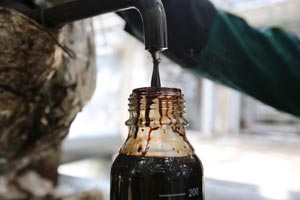Oil Caps Weakest Quarter Since 2009 as Global Glut Seen Growing

Oil slipped, capping the lowest quarterly average price since the start of 2009 as U.S. crude inventories climbed.
West Texas Intermediate futures fell 24% this quarter. Nationwide, stockpiles climbed for the first time in three weeks, according to the Energy information Administration.
Supplies at Cushing, Oklahoma, the delivery point for WTI contracts, declined a fifth week and production fell to a 10-month low.
Oil has plunged more than a quarter from this year’s closing peak in June on speculation a global glut will be prolonged amid a weakening Chinese economy and the return of Iranian barrels to market. U.S. crude stockpiles remain more than 100 million barrels above the five-year seasonal average, while the Organization of Petroleum Exporting Countries pumped more than its 30 million-barrel daily quota for the 16th consecutive month in September.
"It’s been a lousy quarter, but it started off on an optimistic note," Phil Flynn, senior market analyst at the Price Futures Group in Chicago, said by phone. "The Greek crisis was the first piece of negative market news, followed by the deal with Iran and then the biggest factor of all, concern about China."
WTI for November delivery fell 14 cents to settle at $45.09 a barrel on the New York Mercantile Exchange Sept. 30. Prices averaged $46.50 a barrel this quarter, the lowest since the three months ended March 2009.
Brent for November settlement climbed 14 cents to end the session at $48.37 a barrel on the London-based ICE Futures Europe exchange. Prices averaged $51.30 this quarter. The European benchmark crude closed at a $3.28 premium to WTI.
U.S. crude output declined 40,000 barrels a day to 9.1 million last week, the least since the week ended Nov. 28, according to EIA data. Production has slipped in seven of the last eight weeks.
"The crude production number is the most important in the report," Geir Rune Johnskareng, who helps manage $3.8 billion as a portfolio manager at Manulife Asset Management in Montreal, said by phone. "It’s the drop in production that will lead to the eventual balancing of the market."
Nationwide crude stockpiles rose 3.96 million barrels to 457.9 million in the week ended Sept. 25, the EIA said. Supplies at Cushing, Oklahoma, which is the biggest hub in the country, fell by 1.07 million barrels to 53 million, the least since March.
Refineries reduced operating rates by 1.1 percentage point to 89.8% of capacity, the least since March. U.S. refiners typically slow during September to perform maintenance after the end of the summer peak driving season.
"The inventory build of nearly 4 million barrels makes sense," Brian Kessens, a managing director and portfolio manager at Tortoise Capital Advisors in Leawood, Kansas, who helps manage $15.6 billion in energy assets, said by phone. "U.S. production continues to fall, dropping to 9.1 million from 9.6 million in June, and should end the year below 9 million."
Gasoline supplies climbed 3.25 million barrels to 222 million, the highest level since May. Demand for the fuel dropped, which fell 2.1% to 9.02 million last week, remains 4.2% higher than during the same period in 2014.
Traders are keeping an eye on Joaquin, a storm that grew into a Category 1 hurricane as it bore down on the Bahamas, according to the U.S. National Hurricane Center. Forecasters are also trying to gauge the threat to the U.S. While there is little confidence in the long-term track, hurricane center maps show the storm off the Virginia coast by Oct. 5.
"Joaquin probably has some people concerned," Kessens said.
Gasoline futures for October delivery rose 2.62 cents, or 1.9%, to settle at $1.3894 a gallon in New York. The October contract expired Sept. 30.
The Bloomberg Commodity Index has tumbled about 15% since June 30, headed for its worst quarterly performance since the end of 2008. The measure of returns for 22 raw materials fell to its lowest level since 1999 in August.




